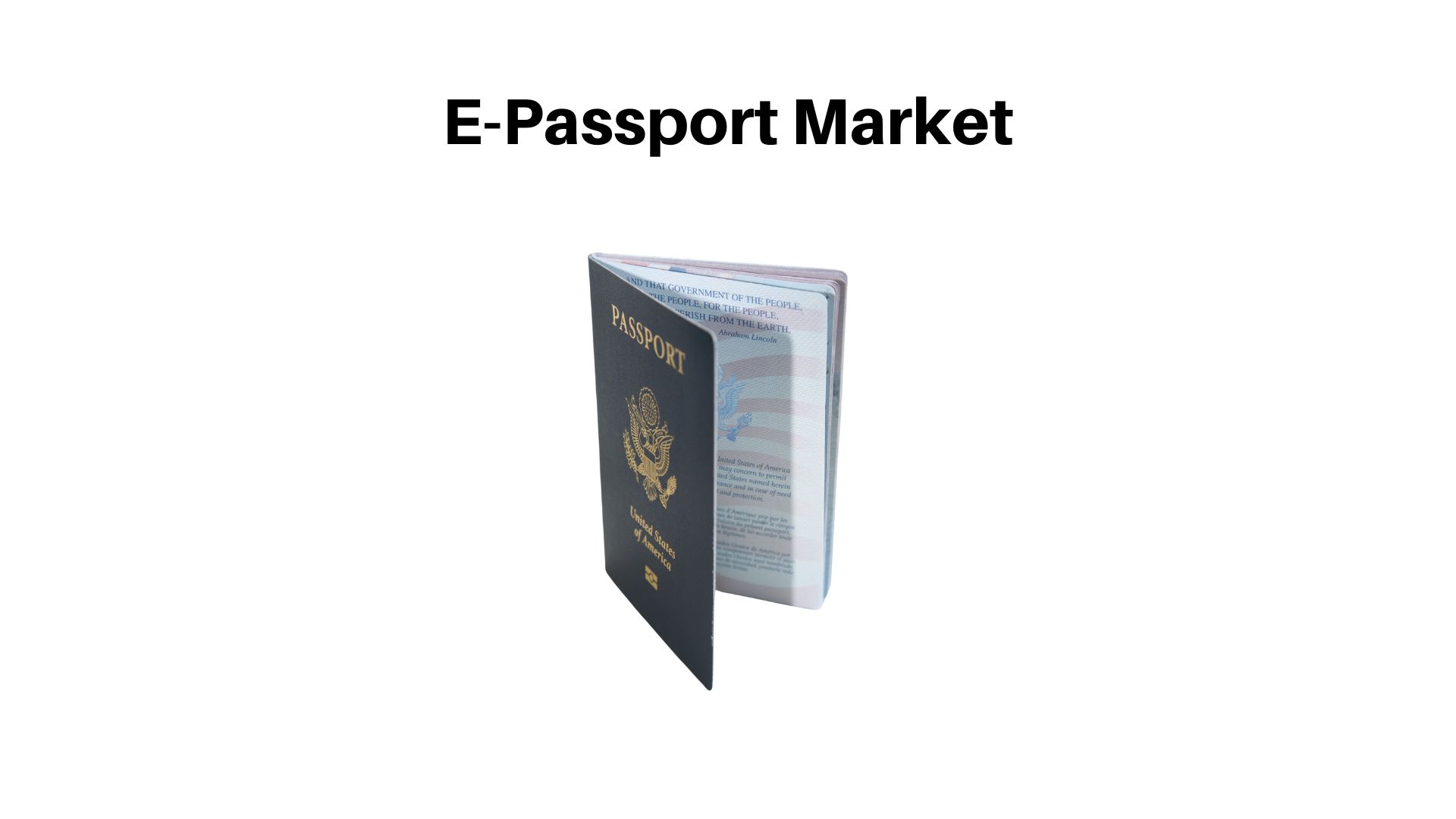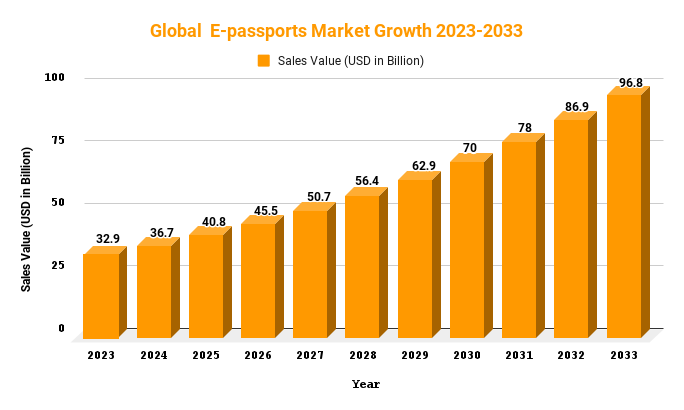Global E-Passport Market Anticipated to Reach USD 96.84 Bn by 2033

Page Contents
Market Overview
Published Via 11Press: E-passports (also referred to as biometric passports) are documents containing an electronic chip containing biometric data belonging to its holder, such as facial recognition data or fingerprints. Their purpose is to improve security and reduce fraud by making forgeries or manipulation more difficult.
Global E-Passport Market Estimated At USD 32.9 Bn In 2023 and Anticipated to Reach USD 96.84 Bn by 2033 With an 11.4% Compound Annual Growth Rate.
Asia Pacific is projected to lead the e-passport market during its forecast period, led by countries like China and India due to their large populations and rising demand for secure travel documents. European markets may experience impressive expansion due to regulations mandating e-passports for visa-free travel.
Overall, the global e-passport market is expected to see strong expansion over the coming years as governments increasingly utilize this technology for improved border security and streamlining travel processes for passengers.
Get additional highlights on major revenue-generating segments, Request an E-passport Market sample report at https://marketresearch.biz/report/e-passport-market/request-sample/
Key Takeaways
- Due to increasing demands for secure and tamper-proof travel documents, the e-passport market is projected to experience rapid expansion over the coming years.
- E-passport sales have seen strong growth over the past several years due to growing concerns over identity theft and terrorism.
- E-passports are intended to increase security and prevent fraud by making it more challenging to forge or alter passports.
- Key players in the global e-passport market include Gemalto NV, Giesecke & Devrient GmbH, IDEMIA, Oberthur Technologies and MorphoTrust USA.
- These companies specialize in developing innovative e-passport solutions that provide travelers with increased security and convenience.
- Implementation of electronic passports should help passengers travel more easily as they will be able to utilize automated passport control systems at airports.
- In the coming years, e-passport market growth is predicted to accelerate as governments around the world increasingly embrace this technology to strengthen border security and facilitate traveler processes.

Regional Snapshot
- Asia Pacific is expected to lead the e-passport market over the forecast period, driven by China and India due to their large populations and rising demand for secure travel documents. Japan and South Korea have also introduced electronic passport systems in order to improve border security while streamlining passenger travel processes.
- Europe should experience rapid expansion in the e-passport market due to new regulations mandating their use for visa-free travel. Europe is among the driving forces behind widespread adoption of e-passport systems; many member states already possess them.
- North American e-passport markets are poised for rapid expansion due to rising fears of identity theft and terrorism. The United States began introducing electronic passport systems back in 2006, while Canada is anticipated to follow suit over time.
- Due to rising demand for secure travel documents, e-passport markets in the Middle East and Africa are projected to experience steady expansion. Many countries in this region are investing in electronic passport systems in order to bolster border security while streamlining passenger travel processes.
- Latin America's e-passport market is projected to experience steady expansion due to increased government initiatives to implement electronic passport systems. Countries such as Brazil and Argentina have already implemented such systems; more nations in Latin America may follow suit in coming years.
Drivers
- Concerns Over Identity Theft and Terrorism: With global security threats increasing, governments across the globe are seeking ways to increase border security and prevent identity theft and fraud. E-passports provide a secure and tamper-proof way of verifying traveler identities; many governments are adopting this technology as part of their security plan.
- Implementation of Regulations Requiring E-Passports: Many countries and regions, such as the European Union, have introduced laws mandating electronic passports for visa-free travel. This has driven their adoption among travelers as travelers must possess such documents to enter without needing visas.
- Security Documents in High Demand: As more and more people travel internationally, demand for secure travel documents has skyrocketed. E-passports offer enhanced levels of protection over traditional paper passports and have quickly become popular options among international travelers.
- Increased Adoption of Automated Border Control Systems: Many countries are adopting automated border control systems that use biometric authentication techniques such as facial recognition to verify traveler identities. E-passports are essential in using such systems, driving their adoption even further.
Restraints
- High Cost of Implementation: Implementation of electronic passports can be costly, as it involves investing heavily in new technology and infrastructure – an expense that may prove prohibitive to smaller countries with limited resources.
- Concerns Regarding Data Privacy: Due to their use containing sensitive biometric data, there are concerns over data privacy in e-passports as there is potential for misuse or hacking by third parties – an especially concerning fact given recent breaches and cyberattacks.
- Technical issues: E-passports may be more complex to use than traditional paper passports, which may create technical difficulties for travelers and lead to delays and frustration, particularly at busy border crossings and airports.
Opportunities
- Adoption in Emerging Markets: While the adoption of e-passports is high among developed nations, emerging markets still present considerable opportunities for expansion. As these markets integrate further with the global economy and demand for secure travel documents increases over time.
- Integration With Other Technologies: E-passports can be combined with various technologies, such as facial recognition and automated border control systems, to enhance traveler experiences. As these technologies advance and become more widespread, their demand may also grow significantly.
- Collaboration with the Private Sector: The e-passport market offers an opportunity for collaboration between governments and private companies in developing and implementing electronic passport systems, providing innovative solutions, and stimulating the growth of this sector of the economy.
- Integrate into Smart City Initiatives: E-passports offer governments an opportunity to improve travel experiences while strengthening border security at once. By connecting e-passports to digital identity platforms and intelligent transportation systems, governments have an excellent opportunity to enhance the travel experience while strengthening border security at once.
Challenges
- Data Privacy and Security Concerns: With the adoption of e-passports comes concerns over their impact on biometric information stored on electronic chips. Governments and e-passport vendors must take care to secure this data against potential cyber attacks as well as misuse.
- Technical Challenges: Implementation of an e-passport can be complex, and technical difficulties associated with their use may present themselves during use, especially if travelers are unfamiliar with this technology. This can cause delays and frustration at busy border crossings or airports.
- Compatibility Issues: As different countries implement and develop their e-passport systems, compatibility issues may arise when travelers use passports from one country to enter another country – leading to delays and confusion for travelers.
- Cost: Implementing an e-passport system can be costly for smaller nations with limited resources, as it must remain affordable to travelers. Governments and e-passport vendors must work together to ensure the cost is reasonable and reasonable pricing should be set for travelers.
- Limitation in Certain Regions: Though electronic passports have become more widely adopted globally, their adoption remains limited in certain regions – creating challenges for travelers who must use traditional paper passports when traveling there.
Market Segmentation
Segmentation by technology:
- Radio Frequency Identification (RFID)
- Biometrics
Segmentation by application:
- Leisure Travel
- Business Travel
Key Players
- Gemalto N.V
- Muehlbauer AG
- Entrust Datacard Corporation
- HID Global Corporation
- Infineon Technologies AG
- Safran SA
- Eastcompeace Technology Co.,ltd
- 4G Identity Solutions Private Limited
- CardLogix Corporation
Report Scope
| Report Attribute | Details |
| Market size value in 2022 | USD 32.9 billion |
| Revenue forecast by 2033 | USD 96.84 billion |
| Growth Rate | CAGR of 11.4% |
| Regions Covered | North America, Europe, Asia Pacific, Latin America, and Middle East & Africa, and Rest of the World |
| Historical Years | 2017-2022 |
| Base Year | 2022 |
| Estimated Year | 2023 |
| Short-Term Projection Year | 2028 |
| Long-Term Projected Year | 2033 |
Recent Developments
- Expanded E-Passport Systems: Many countries around the world are expanding their e-passport systems to increase security and reduce fraud; one example being Moldova's 2021 plans for biometric passports with enhanced security features.
- As concerns over data privacy and security continue to escalate, more attention has been devoted to designing secure e-passport systems that protect biometric traveler information and keep it private. This has resulted in the development of encryption and security technologies to protect electronic chips within passports.
- Integrating E-Passports With Digital Identity Platforms: E-passports are increasingly being integrated with digital identity platforms, including mobile apps and online portals, to allow travelers to manage their travel documents electronically and enhance their overall travel experience. This integration makes e-passports accessible anywhere at anytime – improving traveler convenience while improving overall travel experiences.
- Collaboration Between Public and Private Sectors: Collaboration is increasing between governments and private companies when it comes to developing and implementing electronic passport systems. For instance, in 2020 the European Union awarded a contract to a consortium including Thales and Gemalto to create new generation e-passports.
FAQ
What is an E-Passport Market Research Report?
A: An e-passport market research report is an in-depth examination of the global e-passport market, covering its size, growth trends, opportunities and challenges.
Who provides E-passport market research reports?
A: These reports are produced by market research firms, industry analysts and other organizations who specialize in market analysis and market research.
What information is included in an e-passport market research report?
A: E-passport market research reports generally contain information on market size, growth, trends, opportunities and challenges in multiple regions around the world. They may also feature detailed analyses of key players in each market sector as well as regional examination and market segmentation analysis.
Why Is E-Passport Market Research Crucial?
A: E-passport market research is crucial because it provides insight into market trends, opportunities and challenges affecting this emerging technology market. With this information in hand, businesses and investors can make more informed decisions when making investments into or developing E-Passport related technologies or services.
Where can I locate E-Passport market research reports?
A: E-passport market research reports can be obtained from various market research firms and databases like MarketResearch.com, ResearchAndMarkets.com, Frost & Sullivan and Frost & Sullivan among others. Furthermore, government agencies or industry associations may provide reports with some reports also.
What are some of the key drivers behind the rise in demand for electronic passports?
A: Key drivers include rising concerns over identity theft and terrorism, new regulations mandating their use, and growing demand for secure travel documents.
What are some of the key challenges affecting the e-passport market?
A: Some of the key challenges impacting the e-passport market include data privacy and security concerns, technical challenges, compatibility issues, cost implications, as well as limited adoption in some regions.
What are some recent developments in the e-passport market?
A: Recent advances in e-passport systems include expansion, increased focus on data privacy, integration with digital identity platforms, a collaboration between public and private sectors, as well as advances in biometric technology.
Contact us
Mail: [email protected]
Tel.no:+1 (347) 796-4335
The team behind market.us, marketresearch.biz, market.biz and more. Our purpose is to keep our customers ahead of the game with regard to the markets. They may fluctuate up or down, but we will help you to stay ahead of the curve in these market fluctuations. Our consistent growth and ability to deliver in-depth analyses and market insight has engaged genuine market players. They have faith in us to offer the data and information they require to make balanced and decisive marketing decisions.